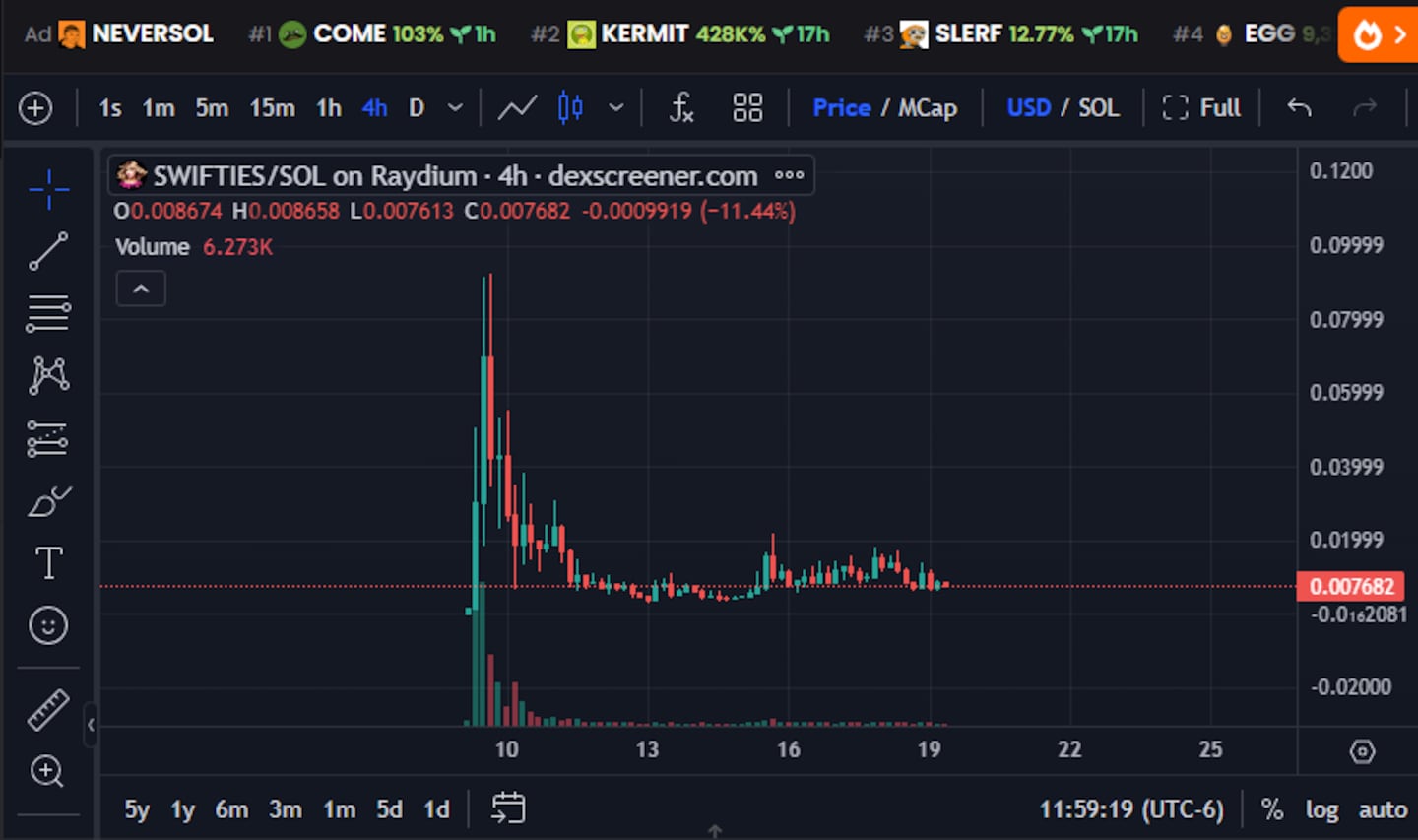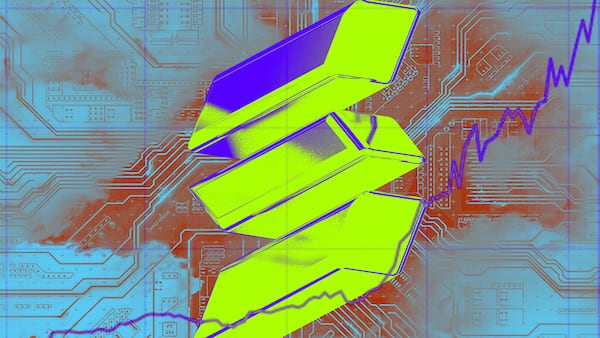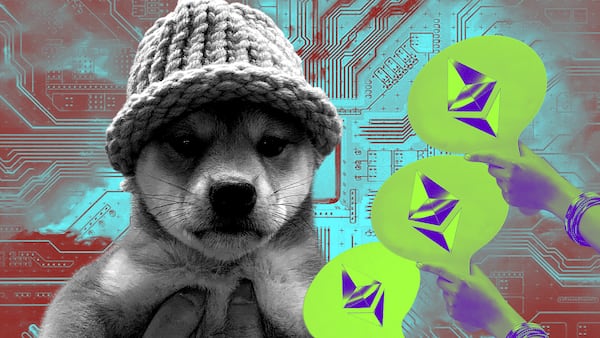- The memecoin frenzy has taken over the crypto market, so I bought some.
- A new trend on Solana involves naming memecoins after celebrities.
- Finding these memecoins early requires going onchain, and tracking tips via Telegram chat rooms.
Memecoins are all the rage in crypto.
The joke cryptocurrencies generated over $10 billion in trading volume today alone. Some of these tokens, like Shiba Inu or Pepe, have billions in market value, while the entire sector is now worth over $49 billion.
Memecoins don’t even pretend to have any utility. They can be named after dogs, frogs, or internet jokes, and they can be so volatile that they make Bitcoin look immobile.
A sign of the frenzy: A funding drive to buy a token called dogwifhat an advertising slot on the Las Vegas sphere raised over $700,000. (It remains to be seen whether the Las Vegas landmark will accept the offer.) And on Tuesday, an NFT of that same dog was sold for $4.3 million.
They are well on their way to breaking into the mainstream, much like their older counterpart Dogecoin did in 2021.
While the sector is derided for being purely speculative, memecoins hold sway among young, crypto-savvy retail types because they see the market as free from venture capital funds and institutional investors that dominate other markets.
That means the playing field is relatively even.
”Memecoins seem to be one of the last remaining opportunities in crypto for a normal person to go from zero to respectable [net worth] in a short period of time,” Jordan Fish, a crypto influencer better known as Cobie, wrote on X.
But with high reward comes a lot of risk. Memecoins can crash just as fast as they can soar.
So how does one buy into memecoins that are destined to balloon into the multi-billion dollar stratosphere?
I decided to hold my breath and dive in.
Going onchain
Before memecoins get listed on centralised exchanges like Coinbase or Binance, they’ll trade on decentralised exchanges — which allow traders to swap tokens without needing a centralised third party.
More than 800 blockchains are able to host memecoins. The biggest blockchains by trading volume are Ethereum, Solana, and Binance Smart Chain, according to DefiLlama data.
I picked Solana, because it’s the hottest blockchain for memecoins.
The network processed 43% more trading volume than Ethereum this weekend despite having 92% less value locked in its protocols. And transactions only cost about four cents.
SWIFTIES, a token named after Taylor Swift, was up roughly 19,600%, even though it was only a few hours old.
I bought roughly $300 in SOL — Solana’s token — on Kraken, a centralised exchange. Then I sent the funds to my Solana browser wallet, Phantom. Unlike exchange accounts, browser wallets allow you to connect with blockchain protocols.
It was time to go shopping. But out of the thousands of memecoins out there, which ones to buy?
Picking coins
I asked plugged-in friends and scrolled through my social media feeds for recommendations.
A popular platform among memecoin traders is DEX Screener, which allows users to see charts for virtually any coin traded on decentralised exchanges. I looked up their suggestions there.
The website itself displays trending coins. That day, SWIFTIES, a token named after pop icon Taylor Swift, was up roughly 19,600%, even though it was only a few hours old.

It grabbed my attention because a different Swift-themed token, dubbed “Taylur,” was trending at the same time. DEX Screener shows the existence of at least 25 other Swift-based coins.
You can differentiate these coins — which sometimes have the same ticker — by looking at their age, liquidity levels, trading volumes, and market values. Their token addresses also work as unique identifiers that help you confirm you’re buying the memecoin you want.
Celebrity memecoins
Swift wasn’t the only celebrity with a memecoin. An emerging trend on Solana involves misspelling the name of a famous person — often a politician — in a silly way.
The first of these celebrity memecoins, as far as I could tell, was named “Doland Tremp.” It launched on February 27.
Derivatives followed, like the tokens called “Jeo Boden” and “Elan Mosk.” And soon enough it was a phenomenon. Jeo Boden captured the lion’s share of attention and rose 1,195,852% in 12 days.
While this particular trend of celebrity memecoin is new, coins named after Donald Trump and Queen Elizabeth II have existed since at least 2022.
The older Trump coin, ticker MAGA, boasts of $300 million in market value, and is by far the largest celebrity memecoin.
The Telegram chat
Memecoin investors congregate into communities on platforms such as Telegram or Discord to discuss a token’s prospects.
I joined the 3,200-member strong Telegram chat dedicated to the Jeo Boden memecoin. It’s a chaotic place.
One bot welcomes newcomers. Another posts a “Buy!” message every time it registers a purchase of the coin above $5,000.
Most participants talk about Boden’s price — telling others they are taking profit, or buying the dip, or asking about price targets.

A lot of them also post Jeo Boden memes. A separate channel has been set up for the purpose of distributing these memes.
Waiting for a shout out
Since memecoins don’t have earnings reports or technological upgrades to spark new interest, their growth relies almost exclusively on marketing campaigns.
The Boden community was eager to get a shout out from trader Zion Thomas, better known as Ansem, who is credited with flagging some smart calls to his more than 240,000 followers.
He touted Solana during its 2022 lows as well as dogwifhat in its early days. Both have soared since.
Thomas had heard about Boden, but has said he only bothers to comment on coins with at least $50 million in market value.
So the community waited for Boden to break that level.
Boden’s market value hovered between $15 million to $45 million for about a week before they got their wish: It reached $50 million off the back of an appearance on Coinbase’s website.
Thomas posted about it, and the token surged 73% in a day.
Dangerous game
But it doesn’t mean Boden is destined to the moon.
A supporter who goes by the name mcbenis wrote in the Telegram chat: “You know how [Shiba Inu] and [dogwifhat] ended up. You know where we are now. And you know what it means if it goes to zero.”
That’s often how traders evaluate their coin’s potential — by comparing its market value to that of another memecoin, and gauging how realistic it is to close the gap.
And going to zero is a very real possibility. One trader lost $147,000 trading 11 different memecoins in just three days.
As for me, I decided to spread my funds across three different tokens — allocating $100 to each.
To purchase the coins, I connected my wallet to Jupiter, a protocol that picks the best prices among various decentralised exchanges on Solana.
One of them immediately plunged 35%, and I took the loss. Another stayed relatively flat.
But the third rose roughly 726% before crashing back down 46%.
God only knows when I’m supposed to sell — if at all?
Update, March 21: This article previously said Jeo Boden was the first misspelled celebrity memecoin launched on March 3. In fact, the Doland Tremp memecoin was the first to launch on February 27. This article has been updated to reflect this.
Tom Carreras is a markets correspondent at DL News. Got a tip about memecoins? Reach out at tcarreras@dlnews.com









